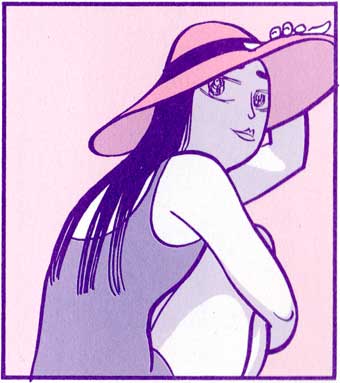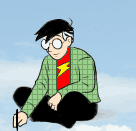Some Thoughts on Asterios Polyp
 First of all, if you haven’t read David Mazzucchelli’s fantastic graphic novel Asterios Polyp, I strongly recommend getting yourself a copy. And stop reading this post now until after you’ve read the book.
First of all, if you haven’t read David Mazzucchelli’s fantastic graphic novel Asterios Polyp, I strongly recommend getting yourself a copy. And stop reading this post now until after you’ve read the book.
If you’ve read Asterios Polyp once…
Read it again.
Seriously, Mazzucchelli’s book is a great re-reading experience. There are things you’re only likely to notice the second or third time around, and at least a few locked doorways in early sections that only open with keys from later chapters. And they’re much more fun if you find them on your own, so again you might want to ignore the rest of these ramblings if you haven’t plunged back in yet.
If you’ve read Asterios Polyp more than once…
Okay, NOW we can talk.
Here are a few things that caught my eye, in no particular order.
Truth-to-Material
Great use of the three “printer’s primaries”: Cyan, Magenta, and Yellow. As symbols of “separation,” as time period markers, as state of mind indicators. Watching them come together late in the book had a transcendent quality for me, and I’ve heard from others that felt the same way.
Mazzucchelli also has a long-standing interest in the process of printing and likes the raw edges of printing itself to show through. His earlier self-published anthology (with painter/partner Richmond Lewis) Rubber Blanket had a similar hand-separated, process-obsessed feel (right down to the name).
There’s an undercurrent of honesty in the presentation. As if the book is saying “I’m not going to lie to you about what I am or where I came from.” This is true about a lot of aspects of the book in fact.
Isolation
The “different styles –> different character” thing is pretty loaded for a ton of reasons, but I especially liked how it reinforces the idea of how each character is in their own universe to a degree. The book is filled with mismatched objects of all kinds thrown into a box that not only have their own appearance but almost their own physics.
Mazzucchelli is a master of western perspecitve when he wants to be, and he demonstrates that during the book. But in a lot of passages, he seems less interested here in creating a sense of continuous space that binds everything and everyone together. Instead, we get flat, isometric, or even childlike views of this landscape of barely compatible things that make up this world.
White Space!
Check out the last 100 years of comics (in the West at least) and you’ll find a lot of variation in the size and shape of comics panels, but almost no variation in the space between panels. Mazzucchelli is a leader in considering that negative space for its role in the story and its role on the picture plane.
Dynamic Balance
Every time the story seems to be stacking the deck in one direction, leading us to think some “lesson” is being taught, or that we can file a character as either worthy or useless, Mazzuccelli introduces a nice counter-weight.
I especially liked how Asterios’ three possessions (the lighter, the watch, the knife) play out. They work so well as markers of maturity, of unburdening, of selflessness, of acceptance of mortality, of putting the past behind him, of learning to value what works over theory, etc.; so harmonious and right that you could almost believe that the universe was ready to reward him. And then the lighter comes back alongside a bottle smashed over his head. Because that’s not the way the universe we live in works.
Hitting Close to Home
A couple of readers have already mentioned that Asterios at his most pedantic looks like he stepped out of the pages of one of my books (right down to the “‘splainin’ hand”). Whether the similarity is intentional or not, it’s a funny deconstruction of the kind of mind that thinks he/she (usually he) can somehow put the whole universe into a series of diagrams, and I’d have to cop to being a poster boy for that mindset.
Fortunately for fools like me, Mazzucchelli is a humanist first, and I think he loves all the fools that populate his story, and has no interest in passing divine judgement. He’s just chronicling the dizzying dance of futility we all participate in, each of us to our own steps and our own tune, as we try to make sense of the unfathomable.














Re: White Space
I love this. You hit it right on the head. He does do a lot of unorthodox things with placement/space so that when he does something more standard and linear, it really strikes a balance.
Also, I love how he chooses not to frame certain moments and instead lets them sit on the page like a centerpiece. Looks pretty natural, but I bet he put a lot of thought in to which moments would take place inside panels and which ones wouldn’t.
I always wanted a treehouse when I was a kid.
On my third read now and I just caught on to the “How many brinks do you see” lesson that Hana gives. It is also this time around that I realized that he’s not watching porn in the beginning.
Anyone else feel a Vonnegut vibe?
“Check out the last 100 years of comics (in the West at least) and you’ll find a lot of variation in the size and shape of comics panels, but almost no variation in the space between panels.”
I’ve seen variation in the space between panels all the time, for example in McFarlane’s work or in some Italian Disney comics.
First, thanks for recommending that I read the book twice. I got more out of it the second time, as one of those “backwards” stories that’s best understood after reading the end. I thought the page designs & the color effects were uneven, the most effective for me was when Asterios went to Hell in a very nice retelling of Orpheus & Euridice. Dynamically the vignette where Hana worries that she’s pregnant didn’t really justify the drama.
But stylistically, I found the book challenging & the interest in it justified. What I found to be the weak point was the story itself, kind of Woody Allen bit, where an older, intensely intellectual man, is brought to life by a naive younger woman. This book didn’t offer any real insights: the loss of Hana made Asterios realize the emotional distance he’s kept from numerous experiences. If Asterios had been given more than a moment of redemption in the form of rejoining with Hana, I think the story would have been more powerful. So, in my view, very interesting comics but not a strong enough story. You really have to love the comics form, because if you don’t love it enough, go to the movie: Woody Allen gives you a similar story in his new movie, & its cheaper, & funnier.
[…] [Review] Asterios Polyp Link: Scott McCloud […]
[…] Parece especialmente interesante el contraste entre la temática de la Odisea, el retorno a Ithaca, y otro mito que aparece de manera recurrente en el tebeo, el de Orfeo y Eurídice, que censura la mirada melancólica. Scott McCloud, cuya influencia es manifiesta en la obra, también aporta su grano de arena: […]
[…] Scott McCloud reviews Asterios Polyp and puts it in a whole new light. […]
Out of all of the things that blew me away with this book, the one thing that stood out for me was the use of and format of the word balloons. Having each character ‘speak’ with a consistent word balloon shape is a device that I don’t recall ever seeing, or at least something that I don’t remember ever noticing in other books.
As for how Mazzucchelli uses the word balloons to give extra weight to certain scenes, there is one example that I still cannot get over. On the 7th last page of the 2nd last chapter, I see three main elements: the drawing, the words, and the two balloons in each panel. I realize that the words are important, and the pictures are as well, but the interaction between the two word balloons from panel to panel tell the story of what is happening between the characters so beautifully, you almost don’t need the words or pictures.
Also, many thanks to Steve Macklin above. I never would have noticed that Asterios wasn’t watching porn in the opening scene without your comment. When I pulled the book out before I started typing, I randomly opened it, and ended up on the page that he is watching in the very first scene of the book. Knowing that, I now have an entirely new perspective on the character. What a crazy book.
10FootBongz beat me to mentioning the word balloon thing but it goes further than that. Mazzuchelli even uses different “fonts” affectively with different characters. His whole type design throughout the book is really beautiful.
My favorite scene is the montage of memories of Hana. The Q-tip scene. Probably the most emotional and affective scene of how a man relates to his wife I’ve seen in a comic since Kevin Huizenga’s short story in Ganges #1 where he’s watching his wife sleeping.
Scott, this is great stuff. Would love to read even more of your thoughts and analysis on this great book. I only just finished my first time through so I need to re-read soon.
Glad you guys brought this up as I am confused by the last interaction between Asterios and Ignazio. I noticed that Ignazio has large ballooons with the font that was used for the narrative. After a few pages though, it eventually gets pared down to the standard Asterios font with square balloons. Mazz must have done this for a reason.
[…] I am not the best writer or reviewer, so once you have read the book and re-read the book, be sure to check out Scott McCloud’s analysis here. […]
[…] McCloud blogged on the book as well. He’s an expert on graphic novels and offers more to think about in […]
Any theories why there is an airplane in every Ignazio dream???
[…] (Scott McCloud: Aus seinem Online Journal) […]
I’m new to comics, so I don’t understand everything you’ve mentioned – but I would like to thank you for taking the time to point out that this book should be read twice.
Read it 9 times. And check out this article that Scott just linked a few topics up:
http://www.nytimes.com/2009/07/26/books/review/Wolk-t.html
I’ve read it once,re-read certain parts several times.Immediately got the 3 things he grabbed,and what was REALLY playing on his TV screen(meaning,not porn).I’m gonna see what other revelations come up.Thanks for mentioning this book.